
Hexen: Beyond Heretic is a fantasy first-person shooter video game developed by Raven Software and published by id Software distributed through GT Interactive on October 30, 1995. It is the indirect sequel to 1994's Heretic, and the second game in Raven Software's "Serpent Riders" trilogy, which culminated with Hexen II. The title comes from the German noun Hexen, which means "witches", and/or the verb hexen, which means "to cast a spell". Game producer John Romero stated that a third, unreleased game in this series was to be called Hecatomb.
Full-motion video (FMV) is a video game narration technique that relies upon pre-recorded video files to display action in the game. While many games feature FMVs as a way to present information during cutscenes, games that are primarily presented through FMVs are referred to as full-motion video games or interactive movies.

Sega Rally Championship is a 1994 racing game developed by Sega AM3 and published by Sega. Originally released for arcades using the Sega Model 2 board, ports were published for the Sega Saturn in 1995 and Microsoft Windows in 1997. Sega Rally Championship simulates driving on different surfaces, with different friction properties, with the car's handling changing accordingly. As the first racing game to incorporate this feature, Sega Rally Championship is considered to be one of the milestones in the evolution of the racing game genre. It was also an early rally racing game and featured cooperative gameplay alongside the usual competitive multiplayer.
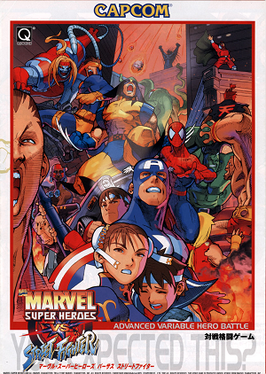
Marvel Super Heroes vs. Street Fighter is a crossover fighting video game developed and published by Capcom. It is the sequel to X-Men vs. Street Fighter and the second installment in the Marvel vs. Capcom series. The game was first released as an arcade game in 1997. It then received ports to the Sega Saturn in 1998 and the PlayStation in 1999.
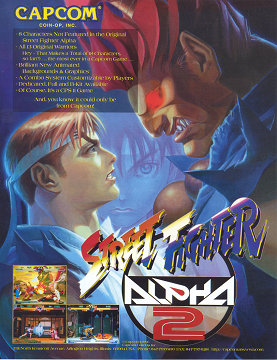
Street Fighter Alpha 2, known as Street Fighter Zero 2 in Japan, Asia, South America, and Oceania, is a 1996 fighting game originally released for the CPS II arcade hardware by Capcom. The game is a remake to the previous year's Street Fighter Alpha: Warriors' Dreams. The game features a number of improvements over the original, such as new attacks, stages, endings, and gameplay features. It was followed by Street Fighter Alpha 3.
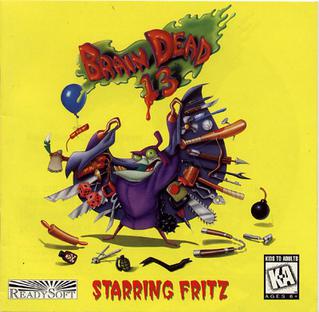
Brain Dead 13 is an interactive movie video game developed and originally published in North America by ReadySoft on 15 December 1995 and in Europe by Empire Interactive on the same year for MS-DOS. Unlike Dragon's Lair and Space Ace, which began as laserdisc arcade games, it was only released for personal computers and video game consoles. In the game, players assume the role of young computer expert Lance Galahad to defeat Dr. Nero Neurosis at his castle and its residents. Its gameplay is primarily presented through the use of full-motion video (FMV).

Marvel Super Heroes is a fighting video game developed by Capcom. Originally released in the arcade in 1995 on the CPS-2 arcade system, it was ported to the Sega Saturn and PlayStation in late 1997. The game, alongside Marvel vs. Capcom: Clash of Super Heroes, was also included in the Marvel vs. Capcom Origins collection, released digitally for the PlayStation 3 and Xbox 360 in September 2012.

Sega Worldwide Soccer 97 is a football video game by Sega released for the Sega Saturn in 1996. It was followed by three more titles: Sega Worldwide Soccer '98 still on the Saturn and two editions of Sega Worldwide Soccer 2000, the second being Sega Worldwide Soccer 2000 Euro Edition for the Dreamcast.

Lina Inverse is a fictional character and the main protagonist of the comic fantasy-themed light novel, manga and anime series Slayers. Lina Inverse is a young yet very powerful sorceress travelling the world in search of adventure and treasure. Lina has been consistently voiced by Megumi Hayashibara in Japanese, dubbed by Lisa Ortiz in the English version of the TV series and by Cynthia Martinez in the English version of the films and original video animation episodes. Slayers novels are narrated by Lina herself from her point of view.

Sega Ages is a series of video game ports, remakes, and compilations published by Sega. It consists of Sega arcade games and home console games, typically those for the Sega Genesis and Master System. The series was launched on the Sega Saturn in 1996. Entries were published for the PlayStation 2 as Sega Ages 2500, a reference to its bargain ¥2500 price point. The series later came to the Xbox 360 and PlayStation 3 as Sega Ages Online, and finally to the Nintendo Switch as simply Sega Ages. The name Sega Ages is a palindrome, with "Ages" being "Sega" backwards — this was previously used by Sega in European marketing strategies from the late 1980s to early 1990s.
A multitap is a video game console peripheral that increases the number of controller ports available to the player, allowing additional controllers to be plugged in simultaneously in a manner similar to a power strip or a USB hub. A multitap often takes the form of a box with three or more controller ports which is then connected to a controller port on the console itself.

Dragon Ball Z: Idainaru Dragon Ball Densetsu is a 1996 fighting video game co-developed by BEC and Tose and published by Bandai for the PlayStation and Sega Saturn. Based upon Akira Toriyama's Dragon Ball franchise, following the Saiyan arc to the conclusion of the Majin Buu saga, it is the first three-dimensional fighting game in the series prior to Budokai Tenkaichi. Its gameplay consists of three-on-three fights taking place on free-roaming 3D arenas, using a main six-button configuration, featuring special moves as well as three playable modes.

Puzzle Bobble 2 is a tile-matching video game by Taito. The first sequel to Puzzle Bobble, it is also known in Europe and North America as Bust-A-Move Again for arcades and Bust-A-Move 2: Arcade Edition for home consoles. Released into the arcades in 1995, home conversions followed for the PlayStation, Sega Saturn, Nintendo 64, and Windows platforms. The game was included in Taito Legends 2, but the US arcade version was included on the US PS2 version instead. Further ports for the Nintendo Switch, PlayStation 4, and Xbox One were released by City Connection alongside Puzzle Bobble 3 in February 2023.
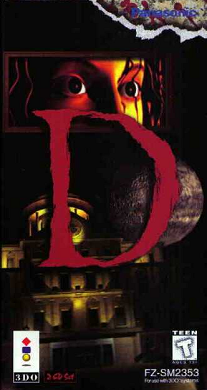
D is a horror-themed interactive movie and adventure game developed by Warp and directed by Kenji Eno. It was first published by Panasonic for the 3DO Interactive Multiplayer in 1995, later being ported to the Sega Saturn, PlayStation, and MS-DOS. The story follows Laura Harris as she goes to investigate a hospital after learning her father went on a mass murdering spree and barricaded himself inside. The hospital morphs into a castle upon her arrival, which she must explore to find her father. The player controls Laura through computer generated full-motion video (FMV) sequences, and must complete the game within two hours without a save or pause function.

Sexy Parodius is a 1996 horizontal-scrolling shooter arcade game developed by Konami. It is the fifth installment of the Parodius series. Like the rest of the series, it is a parody of the Gradius series and other Konami games. It also contains sexual level and enemy designs, as well as risqué innuendo. Many level bosses are women in various erotic costumes or various states of undress.
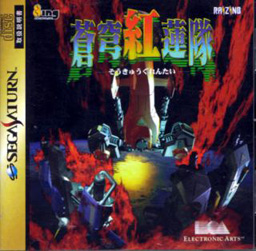
Sōkyūgurentai, also known as Terra Diver, is a vertical-scrolling shooting game by Raizing originally released as an arcade game for the ST-V platform in 1996. The game was ported to the Sega Saturn and PlayStation in 1997, with neither port being released outside of Japan.
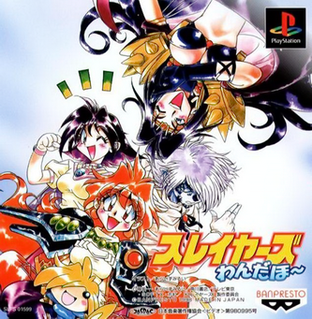
Slayers Wonderful is a role-playing video game developed by TamTam and released by Banpresto for the PlayStation in 1998 exclusively in Japan. It features key voice actors from the Slayers anime versions and a story supervised by the Slayers author Hajime Kanzaka. The game was a big commercial success but received mixed critical reception.
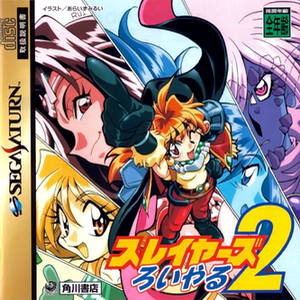
Slayers Royal 2 (スレイヤーズろいやる2) is a tactical role-playing game developed by Onion Egg and published by Entertainment Software Publishing and Kadokawa Shoten in 1998 for the Sega Saturn and in 1999 for the PlayStation, exclusively in Japan. It is a follow-up to 1997's Slayers Royal but is a standalone story in the Slayers franchise and not a direct sequel to its predecessor. The game sold well, but its reviews were mostly only moderately positive.
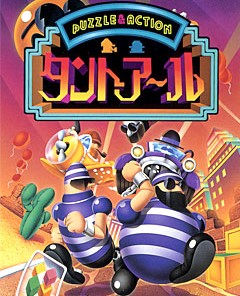
Puzzle & Action: Tant-R, is a puzzle video game developed and published by Sega in 1993 for the Sega System C in Japan. The first instalment in the Puzzle & Action trilogy, it is a spin-off of Bonanza Bros.. The characters from Bonanza Bros., Robo and Mobo, are featured as protagonists, functioning as detectives. A prison escapee is chased, and his henchmen interfere. A series of timed mini-games must be completed to defeat the henchmen. The game features references to western culture.

















